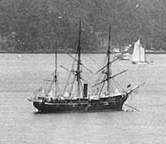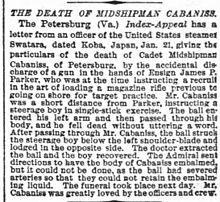Charles Cabaniss

Charles Cabaniss (October 14, 1859 – January 19, 1882) was a
Life
Cabaniss was born on October 14, 1859, in
Cabaniss's academic rankings remained generally the same in his following year at the academy. His scores in drawing, mathematics, and physics were above average, while his merits in French language and history were among the worst. He finished 33rd in the class of 66. He maintained his spot as the most disciplined in his class, earning fewer than half the demerits than the second-best.[4]

Cabaniss finished his final year at the Naval Academy ranking 25th out of 61 graduates. The course requirements changed that year; Cabaniss received poor marks in seamanship, tactics, naval tactics, astronomy, and French language, but very high marks in mathematics, electricity, and English composition courses. He maintained his good conduct, earning the second-fewest demerits of any cadet. His rank was Cadet Midshipman.[5]
That year, the academy fielded its first
Swatara and death

On June 10, 1880, Cabaniss graduated from the academy and was sent home to await his orders. He was assigned on August 17 of that year to the

Cabaniss was killed in an accident on board the Swatara on January 19, 1882. An official report of the incident was released on March 25 of that year. According to the report, before-noon exercises on board the ship had just been completed when an order was made to prepare rifles for target practice. At around ten in the morning, Cabaniss was assisting in the instruction of the ship's second group of sailors when he broke off and entered the ship's engine room to instruct a sailor on his duties. An experienced sailor, Ensign James P. Parker, was explaining to new sailors how to properly load their guns. He showed them how to load and discharge the weapons using a practice round. He then reloaded his gun with live rounds, but apparently forgot this and fired one of them. The bullet ricocheted off the ship's deck, struck one of the guns, ricocheted off the deck again, and struck Cabaniss, killing him instantly. The ball first entered through his left arm, impacting it so strongly that it broke every bone in his elbow. It then entered his side, tearing his latissimus dorsi muscle; went into his chest, severing every major artery; ricocheted up to near his shoulder, exited his right side, and struck the man he was instructing in the shoulder. Cabaniss was reported to have never made a sound as he fell. The other sailor recovered.[15]
Cabaniss' body was ordered to be embalmed but was not; the damage to his body was so severe that the embalming fluid would leak out. His body was buried in Kobe on February 24 with military honors. The entire crew of the Swatara attended, as well as the entire crew of HMS Flying Fish and many noted Japanese citizens. Ensign Parker reportedly suffered from depression following the accident.[13] Cabaniss' death received significant media coverage in the Eastern United States. The New York Times published an article on its second page, and among other papers that carried the story were the Wilmington Morning Star and the Petersburg Index-Appeal.[16][17]
References
Explanatory notes
Footnotes
- ^ Government Printing Office (1877), p. 21
- ^ Government Printing Office (1878), p. 18
- ^ Government Printing Office (1878), p. 31
- ^ Government Printing Office (1879), p. 16
- ^ Government Printing Office (1880), pp. 11–14
- ^ Kroll (2002), p. 14
- ^ Clary (1997), p. 9
- ^ Schoor (1967), p. 5
- ^ a b Bealle (1951), pp. 7–8
- ^ Clary (1997), p. 11
- ^ United States Naval Institute (1882), p. XXI
- ^ a b "Recent Deaths" (February 25, 1882), p. 657
- ^ "Cadet Midshipman Charles Cabaniss" (February 18, 1882), p. 632
- ^ Cooper (March 25, 1882), p. 757
Bibliography
- Bealle, Morris Allson (1951). "1879". Gangway for Navy: The Story of Football At United States Naval Academy, 1879–1950. Washington, D.C.: Columbia Publishing Company. OCLC 1667386.
- Clary, Jack (1997). "The Tradition Begins: 1879–1899". Navy Football: Gridiron Legends and Fighting Heroes. OCLC 36713133.
- OCLC 51269811.
- Kroll, C. Douglas (2002). "The Cadet Years". Commodore Ellsworth P. Bertholf: First Commandant of the Coast Guard. ISBN 1-55750-474-1.
- Schoor, Gene (1967). "Football Comes to Annapolis and West Point". In Schoor, Gene (ed.). The Army-Navy Game: A Treasury of the Football Classic. New York City: OCLC 371756.
- OCLC 813002255.
- United States Naval Academy (1878). Annual Register of the United States Naval Academy, Annapolis, Maryland: Twenty-Eight Academic Year (1877–1878 ed.). Washington, D.C.: Government Printing Office. OCLC 813002256.
- United States Naval Academy (1879). Annual Register of the United States Naval Academy, Annapolis, Maryland: Twenty-Ninth Academic Year (1878–1879 ed.). Washington, D.C.: Government Printing Office. OCLC 813002257.
- United States Naval Academy (1880). Annual Register of the United States Naval Academy, Annapolis, Maryland: Thirtieth Academic Year (1879–1880 ed.). Washington, D.C.: Government Printing Office. OCLC 813002258.
- Staff writer (January 1882). "Necrology: Cadet-Midshipman Charles Cabaniss". OCLC 818922836.
- Staff writer (February 18, 1882). "Recent Deaths: Cadet Midshipman Charles Cabaniss". OCLC 51269811.
- "A Swatara Shipmate" (February 25, 1882). "Recent Deaths: The Late Cadet Midshipman Charles Cabaniss". The United States Army and Navy Journal, and Gazette of the Regular and Volunteer Forces. XIX (30): 657. OCLC 51269811.
External links
 Media related to Charles Cabaniss at Wikimedia Commons
Media related to Charles Cabaniss at Wikimedia Commons
